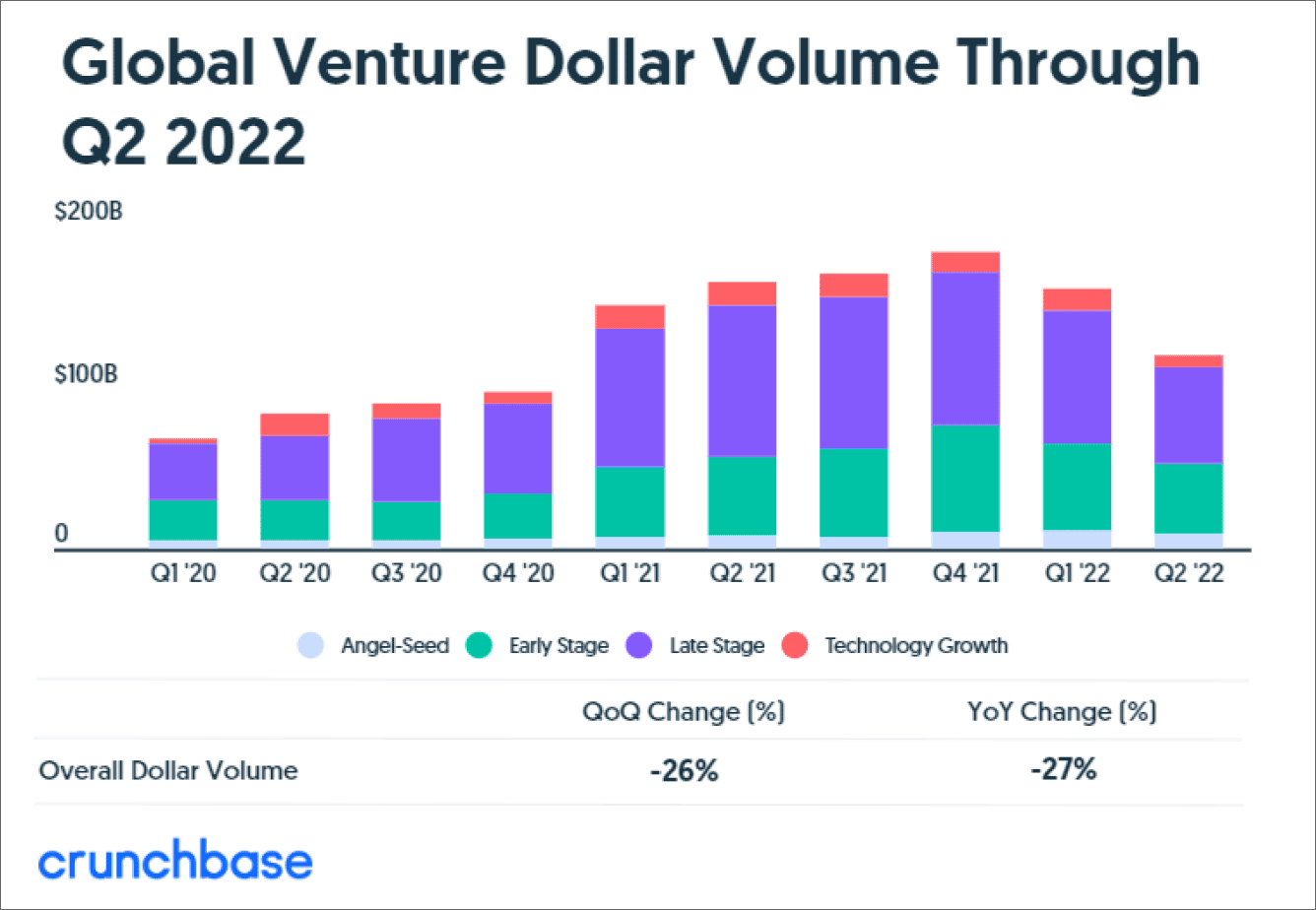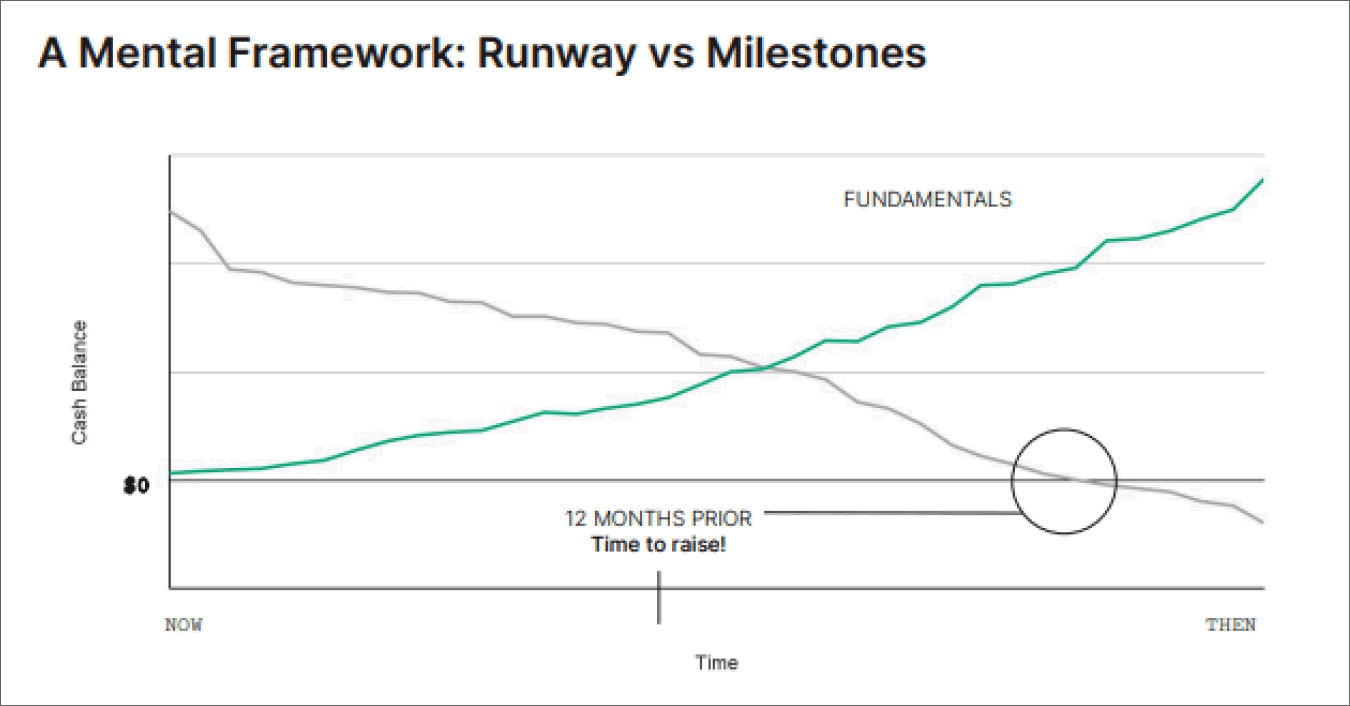Why Do You Need a Downturn Playbook Now?
Recent commentary from the venture ecosystem:
- “No one can predict how bad the economy will get, but things don’t look good,” Y Combinator wrote in a letter to portfolio founders that was first published by TechCrunch. “The safe move is to plan for the worst.”
Y Combinator - “Most important: You have to honestly assess your ability to fundraise in a downturn. The bar has gone way up. Give yourself time to fix any problems in your business. Cut burn asap to give yourself that time.”
David Sacks, Craft Ventures - “Global funding slowed dramatically in the second quarter of 2022 as investors shied away from later-stage funding bets. It also marked the first quarter with a significant drop in funding since the beginning of 2020.”
Crunchbase - “We do not believe that this is going to be another steep correction followed by an equally swift V-shaped recovery…It will be a longer recovery…”
Sequoia Capital - “Founders & executives… have been quick to recognize and adjust… the cost of capital just went way up & high cash burn rates are now impossible.”
Bill Gurley, Benchmark Capital - “Make necessary changes to reduce spending now,” she says. “The earlier you can course correct to stretch your runway, the more optionality you give yourself in the long run.”
Jessica Peltz Zatulove, Hannah Grey VC
Startup Downturn Playbook
Four steps startup founders should take to prepare for a downturn:
1. Keep your ear to the ground
The earlier you receive warning signals, the more valuable they are.
- Make client / customer calls
- Meet with your investors
- Talk to your founders’ networks
- Watch your numbers like a hawk
2. Adjust your fundraising expectations
The fundraising landscape is changing, and founders must reset expectations accordingly.
Venture Capital Funding Globally Down Significantly in Q2 2022

Expect these to increase:
- Lead time and time investment required to raise capital
- Timeline between capital raises
- Investor-friendly terms
Expect these to decrease:
- Number of deals funded
- Amount of capital deployed
- Valuations
- Average funding size per stage
3. Know your runway and seek to extend
Two methodologies for determining the number of months until you run out of cash:
Simplified:
Cash balance / Monthly cash burn
(Cash burn = EBITDA – interest – taxes – capex – change in working capital)
Recommended:
Monthly financial model forecasting # of months until cash out
- Build three year monthly financial model
- Include income statement, balance sheet and cash flow
- Excel or Google Sheets is best tool for early-staged startups
- Cost effective
- Enables customization for your business model
- Planning systems make sense at later stage
- Hire experienced finance support to build financial model
- Cash forecast in model will provide your # months runway
How Much Runway Do You Need?
Some investors have advised all companies target 24-36 months (or even drive to cash flow positive), but reality is more nuanced by company.

Source: Sequoia Capital, Extending Your Runway presentation 5/26/22
Look for Opportunities to Extend Your Runway
Bucket into easy, medium and hard changes. Also consider level of impact on cash flow.
Where to look:
- People Cost
- Ad Spend
- Office Expenses
- Working Capital
- Capex
- Revenue
- Fundraising
Example:
| Easy | Medium | Hard | |
| High Impact | Reduce hiring plans | Hiring freezes | Layoffs |
| Low Impact | Reduce office snack budget | Eliminate gym membership subsidies | Reduce health insurance coverage |
Consider Implementing Easy and Possibly Some Medium Runway Extension Opportunities Now
| Current | Easy Saving Opportunities | Adjusted | |
| Revenue | $110K | $110K | |
| Expense | $230 | -$15K | $215 |
| EBITDA | -$120 | -$105 | |
| Cash Burn | -$100 | -$85K | |
| Cash Balance | $3,000K | $3,000K | |
| Runway | 30 months | +5 months! | 35 months |
4. Build scenario plans
Scenario planning approach:
- Identify your key uncertainties and bucket them into scenarios (likely grouped by expected revenue growth)
- Identify responses to each scenario
- Build financial model for each scenario that achieves targeted runway
- Forecast and monitor trigger points. Be prepared to act and respond quickly
It is common to build three scenarios.
Sequoia shared a scenario planning matrix in their recent Forecasting & Scenario Planning presentation.
- Helpful framework for how to think about scenario planning
- Red/Yellow/Green definitions need to be customized by company
Simplified Example of Scenario Planning
| Base Case | Minor Recession | Prolonged Recession | |
| Revenue | $110K | $88K (-20%) | $66K (-40%) |
| Expense | $230 | 193 (-10%) | $171 (-21%) |
| EBITDA | -$120 | -105 | -$105 |
| Cash Burn | -$100 | -85 | -$85 |
| Cash Balance | $3,000K | $3,000K | $3,000K |
| Runway | 30 months | 35 months | 35 months |
Regular Forecasting and Waterfall Analysis
Implement monthly forecasting process and track changes via waterfall analysis.
- Forecast based on “most likely” scenario
- Identify trigger points that will drive you to shift to an alternate scenario, and implement associated contingency plans
- Waterfall analysis is a helpful tool to track the trigger points and not get misguided by small incremental monthly changes that in aggregate are large variances to original plan; choose several key metrics to monitor
For more details on each step, contact me to request a copy of the full presentation.
